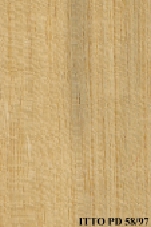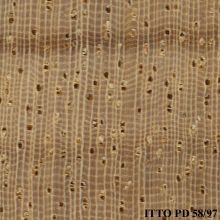
EKUI (Xylopia hypolampra)
Trade Name
Ekui
Scientific Name
Xylopia hypolampra Mildbr.
Family
ANNONACEAE
Common Names
Ndong-eli (Gabon); Biez (Congo); Sangui (Cameroon); Nom akui (Cameroon); Moley (Cameroon); Ekui
Scientific Name Synonyms
Xylopia brieyi De Wild.
Description Of The Tree
Botanical Description
The tree reaches a height of 40 m. The bole is slender, straight and cylindrical. Planks like stilt roots of irregular shape are present at the base. The trunk diameter attains 100 to 130 cm.
Natural Habitat
Xylopia hypolampra occurs in dense forests.
Wood Identification
Anatomic Description Of Wood
Wood diffuse porous. Occasionally vessels exclusively solitary (over 90%). Tangential diameter of vessel lumina 150 to 200 micras (medium). Non-vestured pits. Vessels per mm2 less than 6 (rare). Simple perforation plates. Vessel-ray pits similar to intervessel Axial parenchyma in continuous tangential lines or fine bands. Non-crystals in axial parenchyma cells. 3 to 4 cells per parenchyma strand. Axial parenchyma in narrow bands on lines up to 3 cells wide. Axial parenchyma bands over 4 per mm. 4 to 10 rays per mm (medium). Rays non-storied. Rays 1 to 4 seriate. Homogeneous rays and/or sub-homogeneous rays (all ray cells procumbent). Non-septate fibers. Fibers with simple to minutely bordered pits.
-
 Wood Macro Photo Tangential Plane
Wood Macro Photo Tangential Plane
-
 Wood Micro Photo Of Transversal Section
Wood Micro Photo Of Transversal Section
Availability
Cites Status
Unrestricted
General Wood Description
Color
The heartwood is yellow when freshly cut, darkening slightly to a brown color on exposure, it is not clearly demarcated.
Grain
Straight; grain has no particular influence on drying, machining and finishing qualities.
Texture
The wood is typically fine in texture.
Luster
The wood luster is reported to be rather low.
Natural Durability
Slightly durable to decay. This species needs preservative treatment for uses with risks of occasional re-humidification. It is not suited for uses with risks of permanent or long-lasting humidification. Resistant to termites attack.
Natural durability index (1= Very high durability, 7=Vey low durability)
6
Silica Content
Silica Content: Silica content is negligible. Amounts over 0.05% may affect wood processing. Silica Value: 0
Resistance To Impregnation
Difficult to treat with only a low penetration of the preservative products.
Wood Physical Properties
Basic Density or Specific Gravity (O.D. weight/vol. green) (g/cm³)
0.72
Air-dry Density (Weight and volume at 12%MC) (g/cm³)
0.81
Total shrinkage Tangential (Saturated to 0%MC) (%)
8.7
Total shrinkage Radial (Saturated to 0%MC) (%)
5.1
Drying Defects
Ease of Drying: Drying is fairly easy; some difficulties could occur when drying too fast. Drying Defects: Risks of checks. Kiln Schedules: Schedule proposed as a reference by comparison with well known species taking into account to the general technological behavior of this species.
Dimensional stability ratio (Total Tangential Shrinkage %/Total Radial Shrinkage %)
1.7
Wood Chemical Properties
Wood Mechanical Properties
Bending Strength (MOR),12%MC (kgf/cm²)
1450
Stiffness (MOE) 12%MC (kgf/cm²)
217138
Compression parallel to fiber 12%MC (kgf/cm²)
844
Compression perpendicular to fiber 12%MC (kgf/cm²)
125
Shear strength radial 12%MC (kgf/cm²)
96
Janka hardness (side) 12%MC (kgf)
824
Janka hardness (end grain) 12%MC (kgf)
897
Workability
Sawing
Sawing of this species requires powerful equipment.
Rotary Veneer Cutting
Not suitable for veneering.
Sliced Veneer
Not suitable for veneering.
Blunting Effect
Moderate blunting effect; stellited blades for sawing and carbide tools for machining are advised.
Machining
It needs powerful tools for processing. Possible difficulties caused by interlocked grain are reported.
Planing
Moderately easy; tools must be cautiously sharpened.
Moulding
Moderately easy; tools must be cautiously sharpened.
Turning
30
Boring
Moderately easy; tools must be cautiously sharpened.
Mortising
Moderately easy; tools must be cautiously sharpened.
Nailing
Pre-boring is necessary.
Gluing
Difficult to glue because of high density.
Sanding
Easy to perform; it gives good results.
Polishing
Can be polished without surface preparation.
Response To Hand Tools
Working with hand tools is difficult.
REFERENCED USES
End Uses Summary
EXTERIOR GENERAL, poles, stakes posts, crossties, HOUSING GENERAL, parquet, TURNING, SPORTS, TOOLS, agricultural tools, CONTAINERS, truck bodies, truck flooring, OTHER AND MUSICAL INSTRUMENTS, handicrafts, paper, scale model
Exterior General
- 1 - Tabela de resultados de ensaios fisicos e mecanicos
Poles
- 3 - Estudo dendrologico e determinacao das caracteristicas fisicas e mecanicas do genipapo (Genipa americana)
Stake Posts
- 5 - Propriedades fisicas e mecanicas da madeira e do contraplacado de Pinus elliottii
Crossties
- 8 - Maderas latinoamericas. III, Podocarpus standleyi ,Podocarpus oleifolius, Drims granadensis, Magnolia poasana y Didymopanax pittieri
General Housing
- 10 - Silica in Timbers
Parquet
- 15 - Empire Timbers
Turning
- 30 - Embassy of Honduras in Japan
Sports
- 38 - Annual Review and Assessment of the World Timber Situation 1998-ITTO
Tools
- 42 - Utilización Industrial de Nuevas Especies Forestales en el Perú.
Agricultural Tools
- 44 - Atlas of Peruvian Woods
Truck Body
- 53 - Timbers of the New World
Truck Flooring
- 54 - Bulletin of the Government Forest Experiment Station N.157: Identification of Tropical Woods
Handcraft
- 66 - Maderas latinoamericanas. VII. Caracteristicas anatomicas. propiedades fisicomecanicas, de secado, y tratabilidad de la madera juvenil de Cordia alliodora (Ruiz & Pav. Oken.)
Paper
- 82 - Compilation of Data on the Mechanical Properties of Foreign woods (Part 2) Central and South America.
Scale Models
- 83 - Algunas caracteristicas fisicomecanicas de la madera de tres especies de la cordillera NeoVolcanica
Please Provide Information To View Producer Information